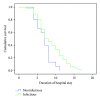Etiology and Outcomes of ARDS in a Rural-Urban Fringe Hospital of South India
- PMID: 24660060
- PMCID: PMC3934087
- DOI: 10.1155/2014/181593
Etiology and Outcomes of ARDS in a Rural-Urban Fringe Hospital of South India
Abstract
Objectives. Etiology and outcomes of acute lung injury in tropical countries may be different from those of western nations. We describe the etiology and outcomes of illnesses causing acute lung injury in a rural populace. Study Design. A prospective observational study. Setting. Medical ICU of a teaching hospital in a rural-urban fringe location. Patients. Patients ≥13 years, admitted between December 2011 and May 2013, satisfying AECC criteria for ALI/ARDS. Results. Study had 61 patients; 46 had acute lung injury at admission. Scrub typhus was the commonest cause (7/61) and tropical infections contributed to 26% of total cases. Increasing ARDS severity was associated with older age, higher FiO2 and APACHE/SOFA scores, and longer duration of ventilation. Nonsurvivors were generally older, had shorter duration of illness, a nontropical infection, and higher total WBC counts, required longer duration of ventilation, and had other organ dysfunction and higher mean APACHE scores. The mortality rate of ARDS was 36.6% (22/61) in our study. Conclusion. Tropical infections form a major etiological component of acute lung injury in a developing country like India. Etiology and outcomes of ARDS may vary depending upon the geographic location and seasonal illnesses.
Figures
Similar articles
-
Etiology and Outcomes of ARDS in a Resource Limited Urban Tropical Setting.J Natl Med Assoc. 2018 Aug;110(4):352-357. doi: 10.1016/j.jnma.2017.07.002. Epub 2017 Jul 18. J Natl Med Assoc. 2018. PMID: 30126560
-
Etiology and outcomes of pulmonary and extrapulmonary acute lung injury/ARDS in a respiratory ICU in North India.Chest. 2006 Sep;130(3):724-9. doi: 10.1378/chest.130.3.724. Chest. 2006. PMID: 16963669
-
[Dynamic measurement of volume of atelectasis area in the evaluation of the prognosis of patients with moderate-to-severe acute respiratory distress syndrome].Zhonghua Wei Zhong Bing Ji Jiu Yi Xue. 2020 Sep;32(9):1056-1060. doi: 10.3760/cma.j.cn121430-20191219-00056. Zhonghua Wei Zhong Bing Ji Jiu Yi Xue. 2020. PMID: 33081890 Chinese.
-
Clinical characteristics and outcomes of patients with acute lung injury and ARDS.J Postgrad Med. 2011 Oct-Dec;57(4):286-90. doi: 10.4103/0022-3859.90077. J Postgrad Med. 2011. PMID: 22120856
-
Relative cost and outcomes in the intensive care unit of acute lung injury (ALI) due to pandemic influenza compared with other etiologies: a single-center study.Ann Intensive Care. 2012 Aug 28;2(1):41. doi: 10.1186/2110-5820-2-41. Ann Intensive Care. 2012. PMID: 22929215 Free PMC article.
Cited by
-
Risk factors for outcomes of acute respiratory distress syndrome patients: a retrospective study.J Thorac Dis. 2019 Mar;11(3):673-685. doi: 10.21037/jtd.2019.02.84. J Thorac Dis. 2019. PMID: 31019754 Free PMC article.
-
Systematic review of the scrub typhus treatment landscape: Assessing the feasibility of an individual participant-level data (IPD) platform.PLoS Negl Trop Dis. 2021 Oct 14;15(10):e0009858. doi: 10.1371/journal.pntd.0009858. eCollection 2021 Oct. PLoS Negl Trop Dis. 2021. PMID: 34648517 Free PMC article.
-
Risk Factors for Death of Burn Patients With Acute Respiratory Distress Syndrome.Ann Burns Fire Disasters. 2023 Dec 31;36(4):271-275. eCollection 2023 Dec. Ann Burns Fire Disasters. 2023. PMID: 38680242 Free PMC article.
-
Pressure-controlled versus volume-controlled ventilation for acute respiratory failure due to acute lung injury (ALI) or acute respiratory distress syndrome (ARDS).Cochrane Database Syst Rev. 2015 Jan 14;1(1):CD008807. doi: 10.1002/14651858.CD008807.pub2. Cochrane Database Syst Rev. 2015. PMID: 25586462 Free PMC article.
-
Association of ratios of visceral fat area/subcutaneous fat area and muscle area/standard body weight at T12 CT level with the prognosis of acute respiratory distress syndrome.Chin Med J Pulm Crit Care Med. 2024 Jun 20;2(2):106-118. doi: 10.1016/j.pccm.2024.05.004. eCollection 2024 Jun. Chin Med J Pulm Crit Care Med. 2024. PMID: 39169930 Free PMC article.
References
-
- Ware LB, Matthay MA. The acute respiratory distress syndrome. The New England Journal of Medicine. 2000;342(18):1334–1349. - PubMed
-
- Agarwal R, Aggarwal AN, Gupta D, Behera D, Jindal SK. Etiology and outcomes of pulmonary and extrapulmonary acute lung injury/ARDS in a respiratory ICU in north India. Chest. 2006;130(3):724–729. - PubMed
-
- Bhadade RR, De Souza RA, Harde MJ, Khot A. Clinical characteristics and outcomes of patients with acute lung injury and ARDS. Journal of Postgraduate Medicine. 2011;57(4):286–290. - PubMed
-
- Force ADT, Ranieri VM, Rubenfeld GD, et al. Acute respiratory distress syndrome: the Berlin Definition. The Journal of the American Medical Association. 2012;307:2526–2533. - PubMed
LinkOut - more resources
Full Text Sources
Other Literature Sources


